A successful organization always knows what their customers want and how to best deliver it to them. Let it be your website’s UI, landing page design or even content, you can make it conversion friendly by giving them what they want simply by understanding your customers .
That’s when buyer persona come into play. You cannot sell anything without knowing your customer. Period.
The major problem with marketers is that they still play the ‘guessing game’ when it comes to framing buyer personas. By having a vague idea about your buyer, you lose out on the essence of your marketing message and will forever be shooting out in the dark hoping you succeed.
To overcome such a marketing blunder, learn how you can map buyer personas to help you understand your customers better and create marketing messages that are tuned for conversions. If you are still not convinced, you should know 82% of companies who use buyer persona say they are able to provide better value proposition.
Step #1: Know Your Target Audience
Your target audience is a particular group of people who makes use of your product or service. Your company survives because they need something that you have to offer.
Usually, if you have no hard data, you would have some assumptions related to your target audience. You make these assumptions either on your knowledge of the pain points your product solve or a guess about their needs.
To confirm your assumptions you can carry out in-depth interviews with your possible customers or make surveys of existing ones. Also, you can always address Google Analytics.
Let’s imagine you are selling an affordable fitness program. To understand a little bit more about your target audience, you can use google analytics data to find out the following about people who visit your website:
- Age: 21 to 55
- Gender: Male or Female
- Location: Atlanta, Georgia (Where you live)
Great! You already have demographic and geographic information of your target market. They give you an overview which will help you create a targeted persona. But it is not enough to build a persona? For that you need data on psychographics and usability behavior as well.
To gather information on usability behavior you can use various tools like heatmaps and video recording. They will give you insights into what attracts your users on the page, how do they review website content and how they proceed through website. Let’s imagine on your fitness program website you have various type of content: articles about healthy meals, short videos with exercises, and success stories. The tools mentioned above will help to understand what type of content is more attractive for your visitors and how they use it.
You can also further talk to your existing clients, do a competitor analysis, participate in online forums, attend health club meetups, etc to understand who your target audiences are. After you do more research you find out more information on your potential buyers:
-
- Fitness Level: Anything
- Main Target:
1) Overweight individuals
2) Individuals looking to get fit or in shape
Step #2: Framing Buyer Personas
Intel noticed that buyer persona the most cost-efficient compared to the other form of marketing.
When I say creating buyer persona, it’s not only putting a face and a story to your key target audience but asking the right question and understanding them. Frame questions that will help you uncover what is user’s buying intent, why would they need your product as well as what’s their purchase trigger. Here are few questions to help you get started to frame your buyer persona.
- What’s their job profile?
- How long do their work per day?
- How many days can they workout?
- Do they follow healthy eating habits?
- What is their sleep pattern like?
You can frame more questions based on your service or product. Also, don’t be surprised when you end up with more than 2 or 3 personas. Just these two golden rules when you frame your personas:
- Not to create too many personas
- Not be vague in describing your persona
Let’s imagine you have noticed two distinct groups within your target audience and turned them into two different personas that you wish to target:
Persona #1:
- Name: July Andersen
- Age: 27
- Profession: A new stay at home mom
- Background: July is the mother of a 6 month old baby, Ruban, and he is her main priority. She has put on over a 40lbs during her pregnancy and is unable to return to her pre-pregnancy weight. She is breastfeeding and loves to eat pasta and drinks a lot of soda. Currently, the major problem is her irregular sleeping pattern and unhealthy diet. She is budget-conscious since she has a lot of expenses with her new baby. She also hates and has not time to cook and resorts to plenty of store bought frozen food.
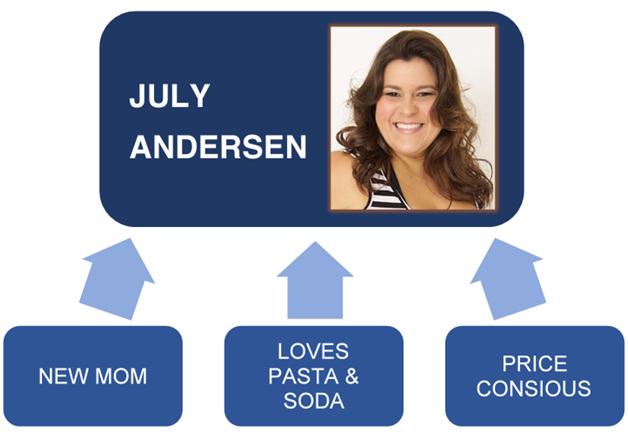
Persona #2
- Name: John Benedict
- Age: 36
- Profession: Data Analyst
- Background: John is married and has 2 kids. He is a workaholic and a gadget freak. He is seen standing in the line to buy the latest Apple device, the day it’s launched. On any given day, he could be seen working up to 12 hours without moving out of his seat. He is borderline obese due to the lack of physical exertion. Also, his favorite activity is to drink beer and play PS3 with his kids. He has tried to exercise, but, gives up because of his hectic schedule. Another major problem is the erratic eating and sleeping habit.

Basically, the two different personas we target is new moms and people with desk jobs. But giving them a life and story helps you understand how we can target them better.
Step #3: Defining What Makes Your Product/Service Different
This is the phase where you need to invest plenty of time and effort. You are going up against hundreds or even thousands of competitors. By showcasing how your service is different and valuable is the biggest deal breaker. By answering these 4 basic questions you will have enough material that will target your buyer persona.
1. Why should he/she choose your service over the others?
In our scenario, both July and John are suffering from lifestyle choices. July, being a new mom, puts her baby’s need first and is extremely budget conscious. She needs an affordable and a personalized fitness program.
According to ITSMA research, 48% of buyers are inclined towards solutions that personalizes their marketing effort. For both our personas, they need a fitness program that works around their daily schedule. They are obviously tired of the traditional gym subscription that doesn’t help them reach their fitness goals. By highlighting how your program is:
- Extremely personalized
- Exercise routines tailor made for each client
- Personal visits to monitor progress
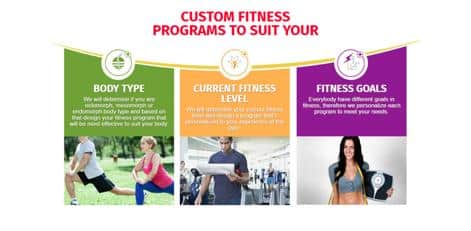
These are the brownie points that help make your program stand out.
2. Why is your service reliable?
Client success stories work as a great testimonial. Talk about previous clients and the success they had with your program. Video testimonials work great wonders for your campaign. This is the space where you can also talk about your passion towards fitness and what motivated you to get into the business. By letting customers know a bit about you, you help them relate better with you as a person and not only as a web page.
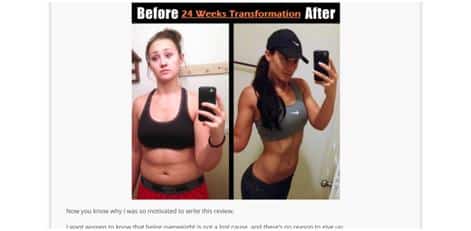
3. What are the critical barriers your customers need to overcome?
Fitness is not a software program to get a consistent result every time you give an input, you need to make customers understand that, unless and until the required effort is put in, it’s impossible to get the desired result. It’s easy for John and July to doubt your credibility, as you are a complete stranger to them. Some level of familiarization and the drip level campaign is essential to break the barrier and establish a flourishing relationship. Get them as subscribers and provide some valuable content to get them on board.
4. What other value service you offer?
Since it’s a remote fitness program, John or July will expect a repository of content and video that help with their fitness goal. Having an exclusive collection of content and videos is extremely valuable. Step-by-step guides and weight loss eBooks are something that will help them understand your style of fitness programs. You could also offer a free consultation, so they get to talk to you and connect with you as their coach.
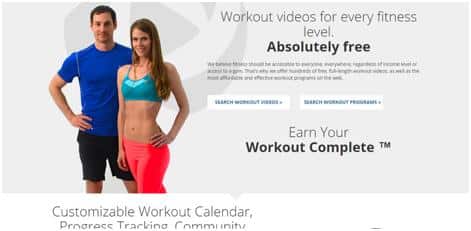
92% of companies generate high quality leads by framing buyer persona. So, this is an important step to understand what sort of value proposition you can offer your potential customers.
Step #4 What Will Trigger Their Buying Decision
MarketingSherpa case study shows that by creating a buyer persona to build customer-centered campaigns, they witnessed a 171% increase in marketing-generated revenue. So, now that you have successfully established a connection with your buyer and have provided them with valuable content, make use of psychology principles to get them on board.
For a price-conscious July, the following techniques could help to convert her:
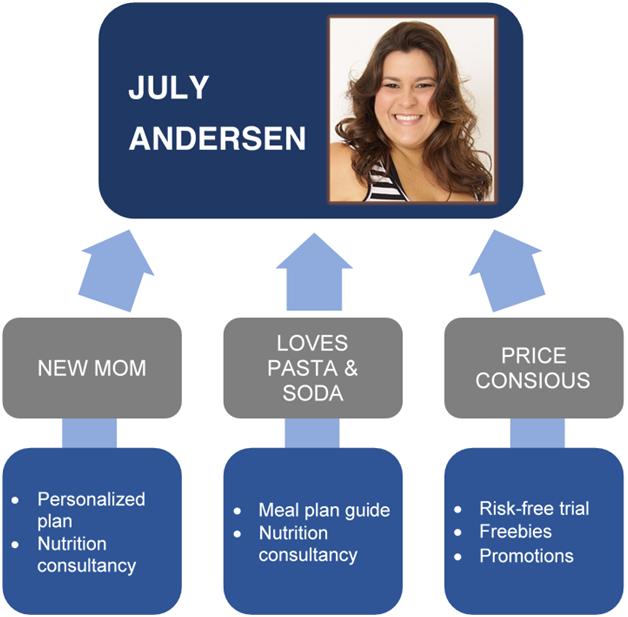
Risk-Free Trial
Providing a risk-free option like a free trial will give the necessary push to get customers on board. When it comes to paid services, customers like July are hesitant to pay upfront as they are not sure about the outcome. Free trials are the perfect way to break the ice and start building your customer base.
Limited Time Offers
Slashing down your prices for a limited time creates a sense of urgency and gives opportunity for price conscious customers to try your service.
Freebies
Create valuable content like the ‘Perfect Meal Guide’ or ’30-Day Effective Weight Loss Diet’ to offer for free to your customers who sign up for your paid services. Everyone loves freebies and when it aids weight loss and is of some other value, customers are more than willing to convert.
Free Nutrition Consultancy
Physically monitor and measure your user’s vital to understand their current physical status. Create a free diet plan to help your users eat healthy.
For the gadget freak workaholic John you can try the following:
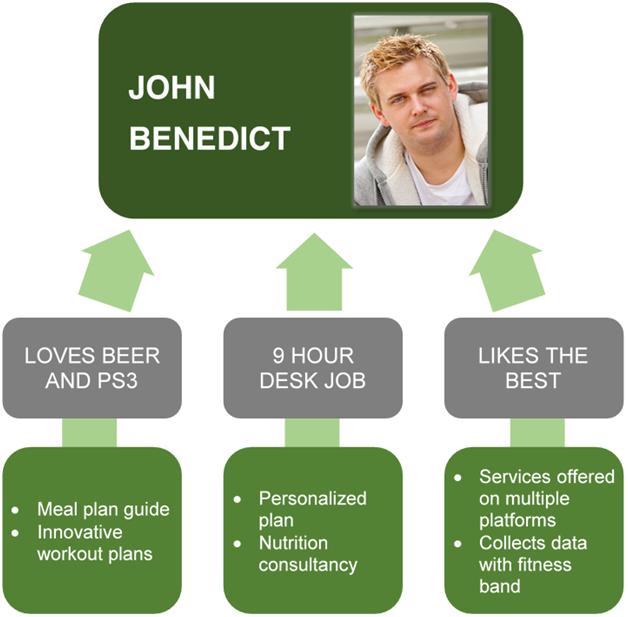
Connected Services
Your fitness program should be available in his smartphone, laptop, smart TV, etc. as connectivity will be something John interested in.
Visually Track Progress
A dashboard that lets John track his fitness data. As a data analyst he will only believe when the data talks to him. Also a visual tracker is the best way to let users understand their fitness status.
Gadget-Friendly Fitness Program
Your program can involve the use the latest fitness tracking device or make use of PS3 games to make your users move. It’s always more fun when you incorporate techs within your workout routine. You will definitely have John sign up instantly for the most gadget-friendly program.
Create A Brand For yourself
This is not something you can achieve overnight and requires a lot of hard work. But once you brand yourself, it’s easy to convert customers like John who likes to have best of everything.
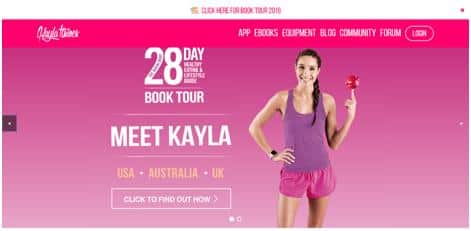
Understanding More About Your Audience And Yourself:
Buyers persona not only helps you frame the right marketing messages but also lets you understand where you can find them. Let it be social media or forums or affiliate marketing, you will know exactly how to reach them with detailed information about who they are.
You can easily build a dominant presence with various content and branding techniques which drives in targeted traffic onto your website.
Over To You
Buyer personas are a great indicator of how to target customers. Top companies are known to map nearly 90% of their database by framing buyer personas.
By understanding their needs, you can start framing strategies that speak the best to their emotions. It’s easier to convert them when you know who you customers are and how to map them with your service. Start creating various personas for each campaign to understand how to target customers for improved conversions.



